1994 PONTIAC BONNEVILLE engine
[x] Cancel search: enginePage 4 of 290
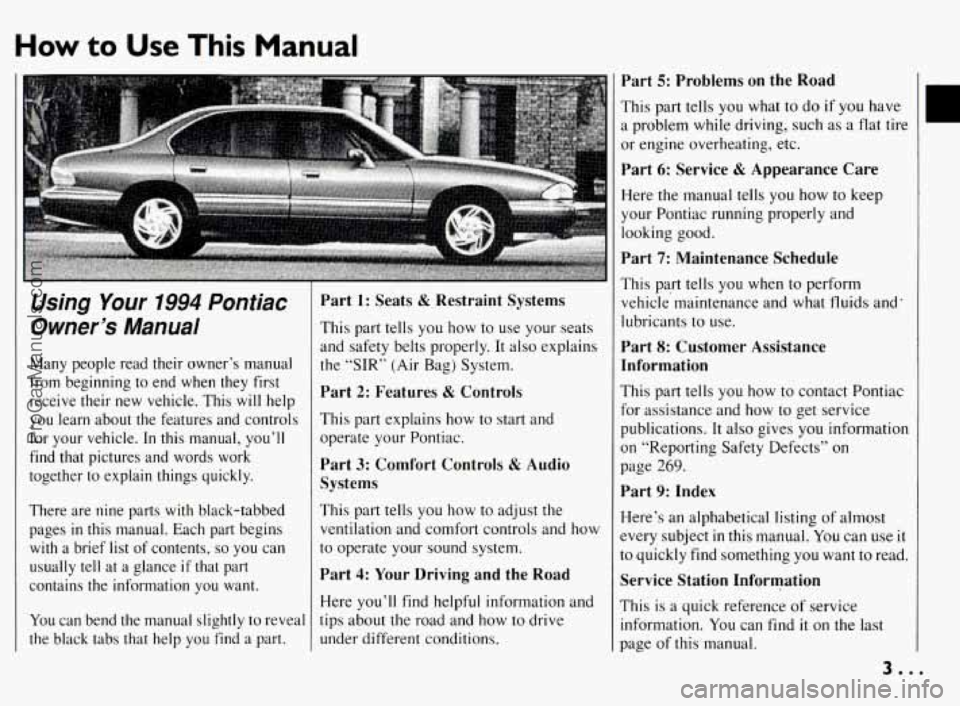
How to Use This Manual
Using Your 1994 Pontiac
Owner’s Manual
Many people read their owner’s manual
from beginning
to end when they first
receive their
new vehicle. This will help
you learn about the features and controls
for your vehicle. In this manual, you’ll
find that pictures and words work
together
to explain things quickly.
There are nine parts with black-tabbed pages
in this manual. Each part begins
with a brief list of contents,
so you can
usually tell at a glance
if that part
contains the information you want.
You can bend the manual slightly to reveal
the black tabs that help you find a part.
This part tells you how to use your seats
and safety belts properly. It also explains
the “SIR’ (Air Bag) System.
Part 2: Features & Controls
This part explains how to start and
operate your Pontiac.
Part 3: Comfort Controls & Audio
Systems
This part tells you how to adjust the
ventilation and comfort controls and how
to operate your sound system.
Part 4: Your Driving and the Road
Here you’ll find helpful information and
tips about the road and how
to drive
under different conditions.
Part 5: Problems on the Road
This part tells you what to do if you have
a problem while driving, such as a flat tire
or engine overheating, etc.
Part 6: Service & Appearance Care
Here the manual tells you how to keep
your Pontiac running properly and
looking good.
Part 7: Maintenance Schedule
This part tells you when to perform
vehicle’maintenance and what fluids and’
lubricants to use.
Part 8: Customer Assistance
Information
This part tells you how to contact Pontiac
for assistance and how
to get service
publications. It also gives
you information
on “Reporting Safety Defects”
on
page 269.
Part 9: Index
Here’s an alphabetical listing of almost
every subject
in this manual. You can use it
to quickly find something you want to read.
Service Station Information
This is a quick reference of service
information.
You can find it on the last
page of this manual.
3..
ProCarManuals.com
Page 6 of 290
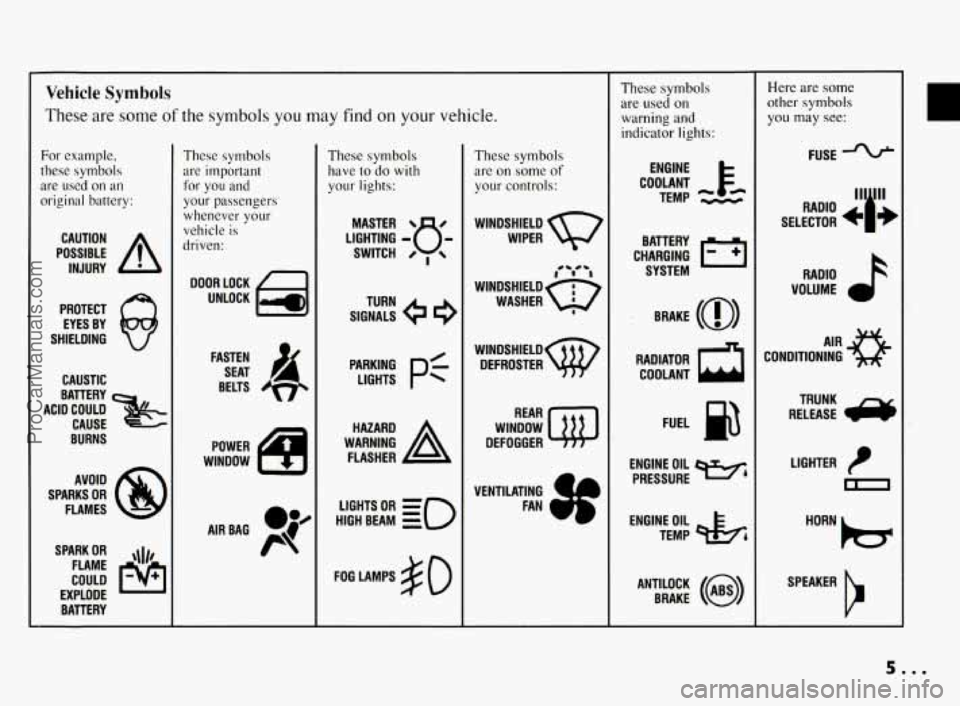
Vehicle Symbols
These are some of the symbols you may find on your vehicle.
For example,
these symbols
are used on an
original battery:
POSSIBLE A
CAUTION
INJURY
PROTECT EYES BY
SHIELDING
CAUSTIC
ACID COULD BATTERY
CAUSE
BURNS
AVOID
SPARKS
OR
FLAMES
SPARK
OR ,111,
COULD FLAME
EXPLODE BATTERY
These symbols
are important
for you and
your passengers
whenever your
vehicle
is
driven:
DOOR LOCK
UNLOCK
FASTEN SEAT
4
BELTS
POWER
WINDOW
'* -- I
These symbols
have to do with
your lights:
SIGNALS e
TURN
HIGH BEAM
OR = =o
FOG LAMPS $0
These symbols
are
on some of
your controls:
WIPER Q7
WINDSHIELD
DEFROSTER
WINDOW
DEFOGGER
VENTILATING
4
FAN (I
These symbols
are used
on
warning and
indicator lights:
COOLANT Fa
TEMP --
ENGINE
CHARGING
I-1
BATTERY SYSTEM
BRAKE
(0)
RADIATOR COOLANT
FUEL
ENGINE OIL
PRESSURE
Wb
TEMP OIL ?b
ANTILOCK (@)
BRAKE
Here are some
other symbols
you may see:
FUSE
11lp RADIO , - -
SELECTOR b I JE
RADIO
VOLUME
CONDITIONING
AIR 43
LIGHTER
m
SPEAKER
b
5.00
ProCarManuals.com
Page 49 of 290
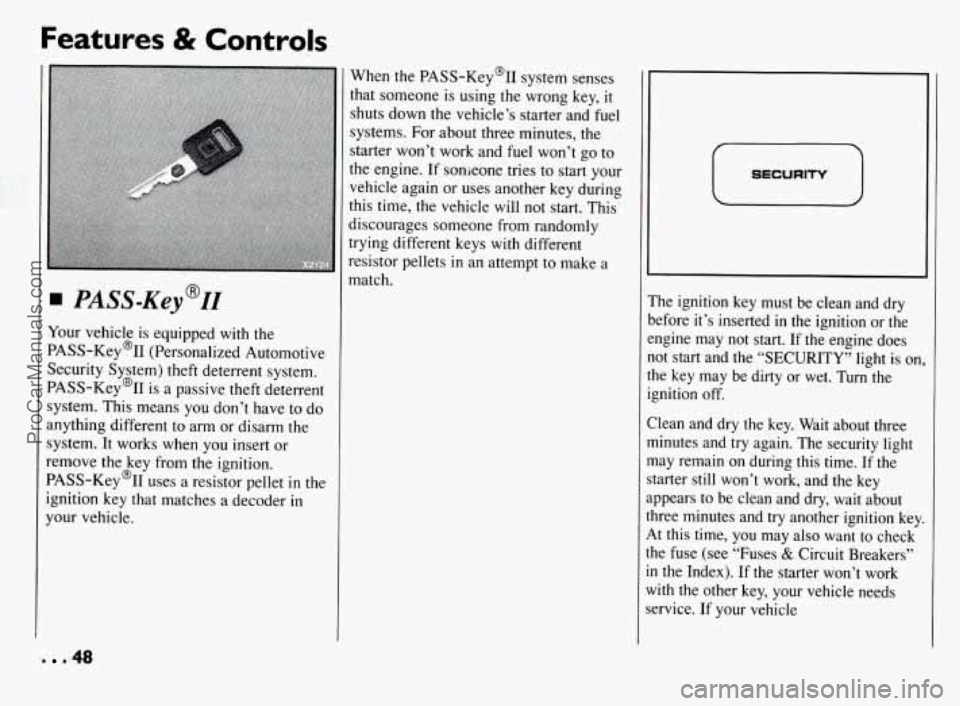
Features & Controls
Your vehicle is equipped with the
PASS-Key’II (Personalized Automotive
Security System) theft deterrent system.
PASS-Key’II is a passive theft deterrent
system. This means you don’t have to do
anything different to arm or disarm the
system. It works when you insert or
remove the key from the ignition.
PASS-Key@II uses a resistor pellet
in the
ignition key that matches a decoder
in
your vehicle. When
the PASS-Key@II system senses
that someone is using the wrong key,
it
shuts down the vehicle’s starter and fuel
systems. For about three minutes, the
starter won’t work and
fuel won’t go to
the engine. If someone tries to start your
vehicle again or uses another key during
this time, the vehicle will not start. This
discourages someone from randomly
trying different keys with different
resistor pellets in an attempt to make a
match.
7 SECURITY
The ignition key must be clean and dry
before it’s inserted in the ignition or the
engine may not start. If the engine does
not start and the “SECURITY” light is on,
the key may be dirty or wet. Turn the
ignition off.
Clean and dry the key. Wait about three
minutes and try again. The security tight
may remain on during this time. If the
starter still won’t work, and the key
ippears to be clean and dry, wait about
:hree minutes and try another ignition key.
4t this time, you may also want to check
the fuse (see “Fuses
& Circuit Breakers”
in the Index). If the starter won’t work
with the other key, your vehicle needs
service. If your vehicle
. -48
ProCarManuals.com
Page 50 of 290
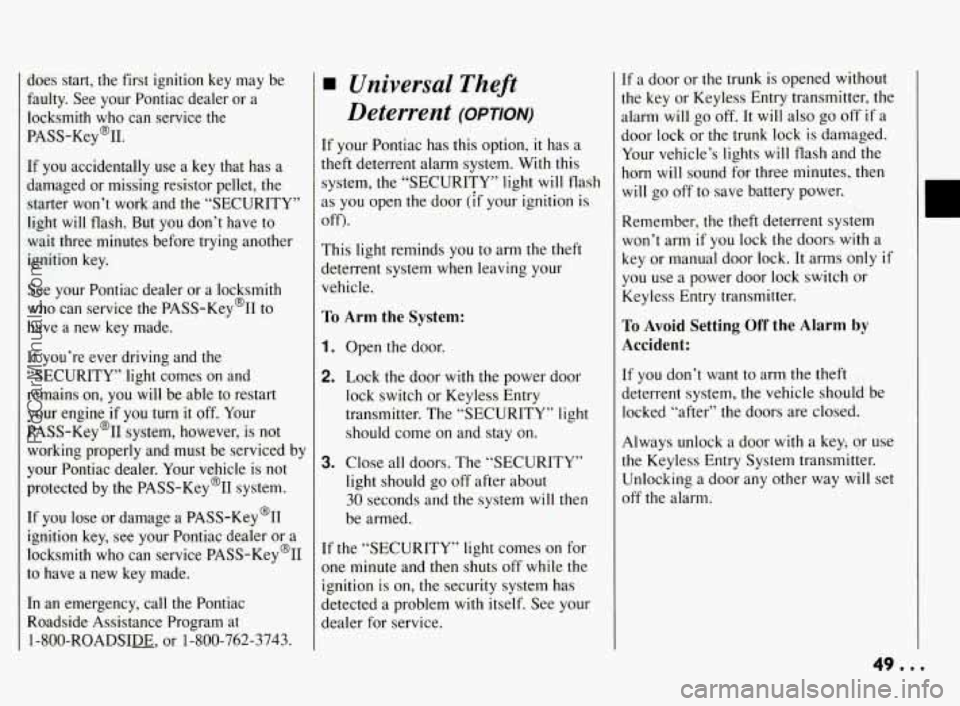
does start, the first ignition key may be
faulty. See your Pontiac dealer or a
locksmith who can service the
PASS-Key’II.
If you accidentally use
a key that has a
damaged
or missing resistor pellet, the
starter won’t work and the “SECURITY”
light
will flash. But you don’t have to
wait three minutes before trying another
ignition key.
See your Pontiac dealer or a locksmith
who can service the PASS-Key@II to
have
a new key made.
If you’re ever driving and the
“SECURITY” light comes on and
remains on, you
will be able to restart
your engine
if you turn it off. Your
PASS-Key@II system, however, is not working properly and must be serviced by
your Pontiac dealer. Your vehicle is not
protected by the PASS-Key@II system.
If you lose or damage
a PASS-Key@II
ignition key, see your Pontiac dealer or a
locksmith who can service PASS-Key@II
to have a new key made.
In an emergency, call the Pontiac
Roadside Assistance Program at
1-800-ROADSIDE, or
1-800-762-3743.
Universal Theft
Deterrent
-(OPTION)
If your Pontiac has this option, it has a
theft deterrent alarm system. With this
system, the “SECURITY”
light will flash
as you open the door
(if your ignition is
off).
This light reminds you to arm
the theft
deterrent system when leaving your
vehicle.
To Arm the System:
1. Open the door.
2. Lock the door with the power door
lock switch or Keyless Entry
transmitter. The “SECURITY” light
should come on and stay on.
3. Close all doors. The “SECURITY”
light should go off after about
30 seconds and the system will then
be armed.
If the “SECURITY” light comes on for
one
minute and then shuts off while the
ignition is on, the security system has
detected a problem with itself. See your
dealer for service.
If a door or the trunk is opened without
the key or Keyless Entry transmitter, the
alarm
will go off. It will also go off if a
door lock or the trunk lock is damaged.
Your vehicle’s lights
will flash and the
horn
will sound for three minutes, then
will go off to save battery power.
Remember, the theft deterrent system
won’t arm
if you lock the doors with a
key or manual door lock. It arms only if
you use a power door lock switch or
Keyless Entry transmitter.
To Avoid Setting Off the Alarm by
Accident:
If you don’t want to arm the theft
deterrent system, the vehicle should be
locked “after”
the doors are closed.
Always unlock
a door with a ke,y; or use
the Keyless Entry System transmitter.
Unlocking a door any other way will set
off the alarm.
ProCarManuals.com
Page 51 of 290
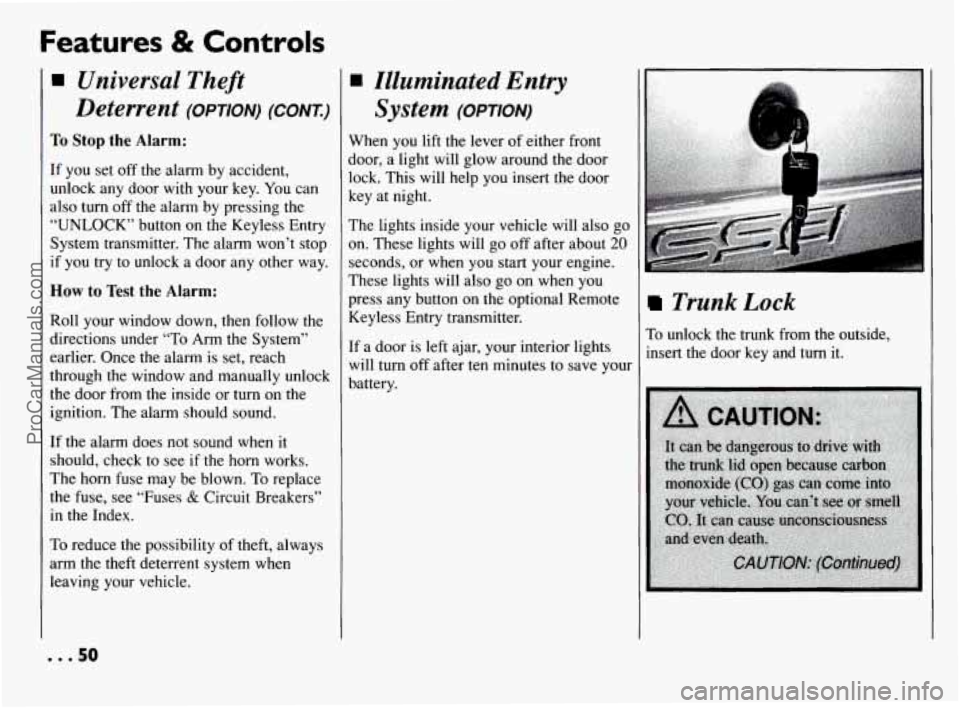
Features & Controls
Universal Theft
Deterrent
(omoN) (CONI)
To Stop the Alarm:
If you set off the alarm by accident,
unlock any door with your key.
You can
also
turn off the alarm by pressing the
“UNLOCK” button on the Keyless Entry
System transmitter. The alarm won’t stop
if you try to unlock a door any other way.
How to Test the Alarm:
Roll your window down, then follow the
directions under
“To Arm the System”
earlier. Once the alarm is set, reach
through the window and manually unlock
the door from the inside or
turn on the
ignition. The alarm should sound.
If the alarm does not sound when it
should, check to see
if the horn works.
The horn fuse may be blown. To replace
the fuse, see “Fuses
& Circuit Breakers”
in the Index.
To reduce the possibility
of theft, always
arm the theft deterrent system
when
leaving your vehicle.
H Illuminated Entry
System
(omoN)
When you lift the lever of either front
door, a light will glow around the door
lock. This will help you insert the door
key at night.
The lights inside your vehicle will also
go
on. These lights will go off after about 20
seconds, or when you start your engine.
These lights will also
go on when you
press any button on the optional Remote
Keyless Entry transmitter.
If a door is left ajar, your interior lights
will turn
off after ten minutes to save your
battery.
Trunk Lock
To unlock the trunk from the outside, insert the door key and
turn it.
... 50
ProCarManuals.com
Page 54 of 290
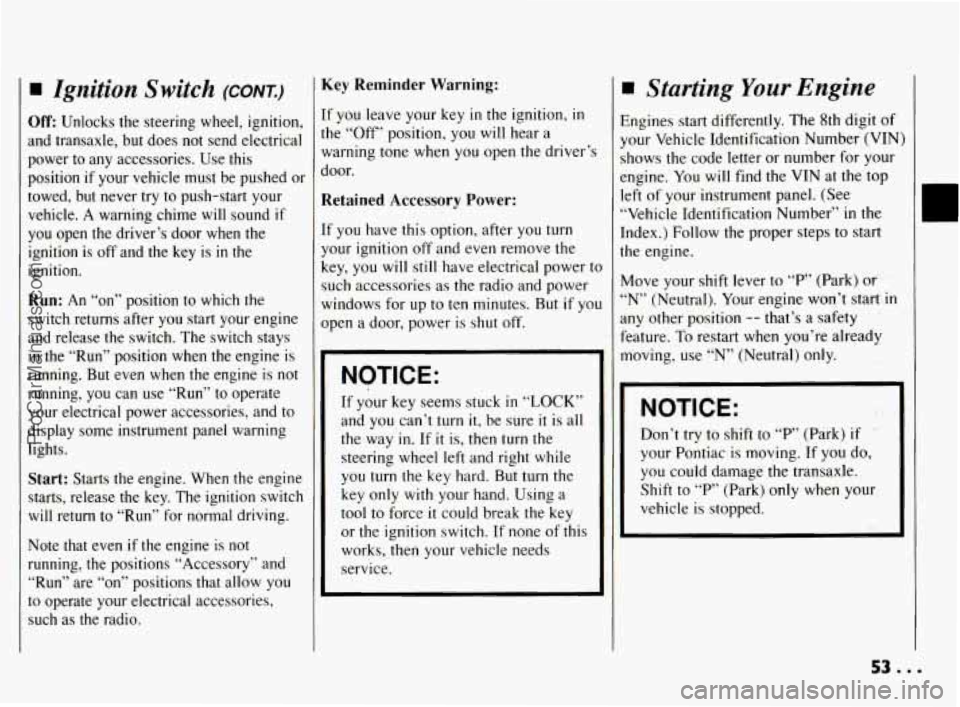
Ignition Switch (CONK)
Off: Unlocks the steering wheel, ignition,
and transaxle, but does not send electrical
power to any accessories. Use this
position
if your vehicle must be pushed or
towed,
but never try to push-start your
vehicle.
A warning chime will sound if
you open the driver’s door when the
ignition is off and the key is
in the
ignition.
Run: An “on” position to which the
switch returns after you start your engine
and release the switch. The switch stays
in the “Run” position when the engine is
running. But even when the engine is not
running, you can use “Run” to operate
your electrical power accessories, and to
display some instrument panel warning
lights.
Start: Starts the engine. When the engine
starts, release the key. The ignition switch
will return to “Run” for normal driving.
Note
that even if the engine is not
running, the positions “Accessory” and
“Run” are “on” positions that allow you
to operate your electrical accessories,
such as the radio.
Key Reminder Warning:
If you leave your key in the ignition, in
the “Off’ position, you will hear a
warning tone when you open the driver’s
door.
Retained Accessory Power:
If you have this option, after you turn
your ignition
off and even remove the
key, you
will still have electrical power to
such accessories as the radio and power
windows for
up to ten minutes. But if you
open
a door, power is shut off.
NOTICE:
If your key seems stuck in “LOCK”
and you can’t turn it, be sure it is all
the way
in. If it is, then turn the
steering wheel left and right
while
you turn the key hard. But turn the
key only
with your hand. Using a
tool to force it could break the key
or the ignition switch. If none
of this
works,
then your vehicle needs
service.
Starting Your Engine
Engines start differently. The 8th digit of
your Vehicle Identification Number (VIN)
shows the code letter or number for your
engine. You
will find the VIN at the top
left of your instrument panel. (See
“Vehicle Identification Number”
in the
Index.) Follow the proper steps to start
the engine.
Move your shift lever to
“P’ (Park) or
“N” (Neutral). Your engine won’t start in
any other position -- that’s a safety
feature. To restart when you’re already
loving, use
“N” (Neutral) only.
NOTICE:
Don’t try to shift to “P” (Park) if
your Pontiac is moving. If you do,
you could damage the transaxle.
Shift to
“P” (Park) only when your
vehicle is stopped.
ProCarManuals.com
Page 55 of 290
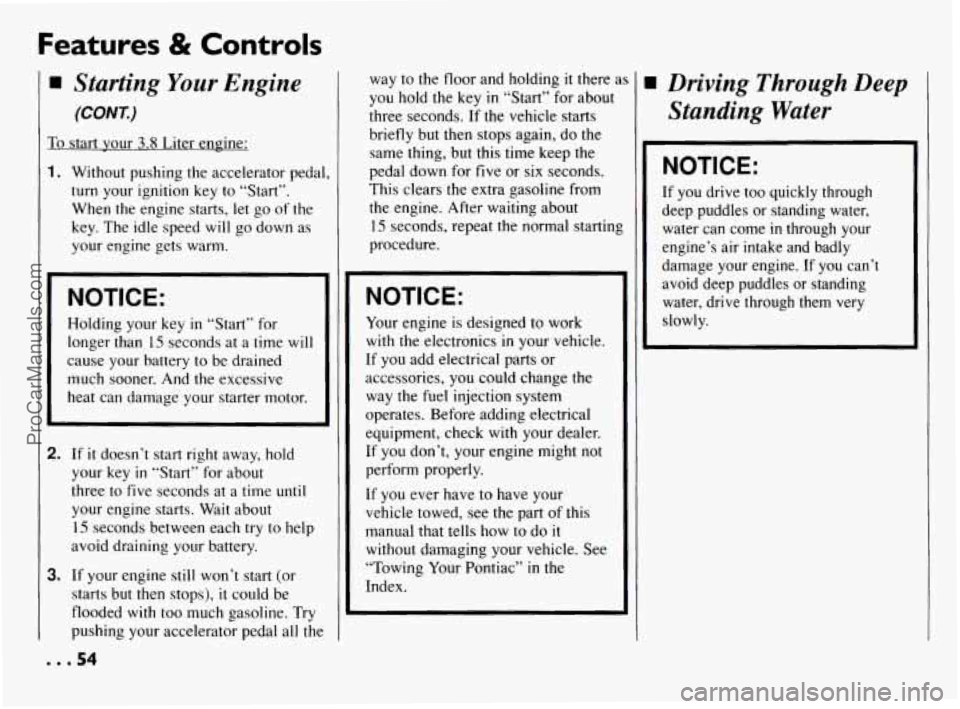
Features & Controls
.
Starting Your Engine
(CONK)
To start your 3.8 Liter engine:
1. Without pushing the accelerator pedal,
turn your ignition
key to “Start”.
When the engine starts,
let go of the
key. The idle speed will go down as
your engine gets warm.
NOTICE:
Holding your key in “Start” for
longer than
15 seconds at a time will
cause your battery
to be drained
much sooner. And the excessive
heat can damage your starter motor.
2. If it doesn’t start right away, hold
your key
in “Start” for about
three to five seconds at a time until
your engine starts. Wait about
15 seconds between each try to help
avoid draining your battery.
3. If your engine still won’t start (or
starts but then stops),
it could be
flooded with
too much gasoline. Try
pushing your accelerator pedal all the
,.a54
way to the floor and holding it there a
you hold the key in “Start” for about
three seconds.
If the vehicle starts
briefly but then stops again, do the
same thing, but this time keep the
pedal down for five or six seconds.
This clears the extra gasoline from
the engine. After waiting about
15 seconds, repeat the normal startin8
procedure.
NOTICE:
Your engine is designed to work
with the electronics
in your vehicle.
If you add electrical parts or
accessories, you could change the
way the fuel injection system
operates. Before adding electrical
equipment, check with your dealer. If you don’t, your engine might not
perform properly.
If you ever have to have your
vehicle towed, see the part of this
manual that tells how
to do it
without damaging your vehicle. See
“Towing Your Pontiac”
in the
Index.
I Driving Through Deep
Standing Water
NOTICE:
If you drive too quickly through
deep puddles or standing water,
water can come
in through your
engine’s air intake and badly
damage your engine. If you can’t
avoid deep puddles or standing
water, drive through
them very
slowly.
ProCarManuals.com
Page 56 of 290
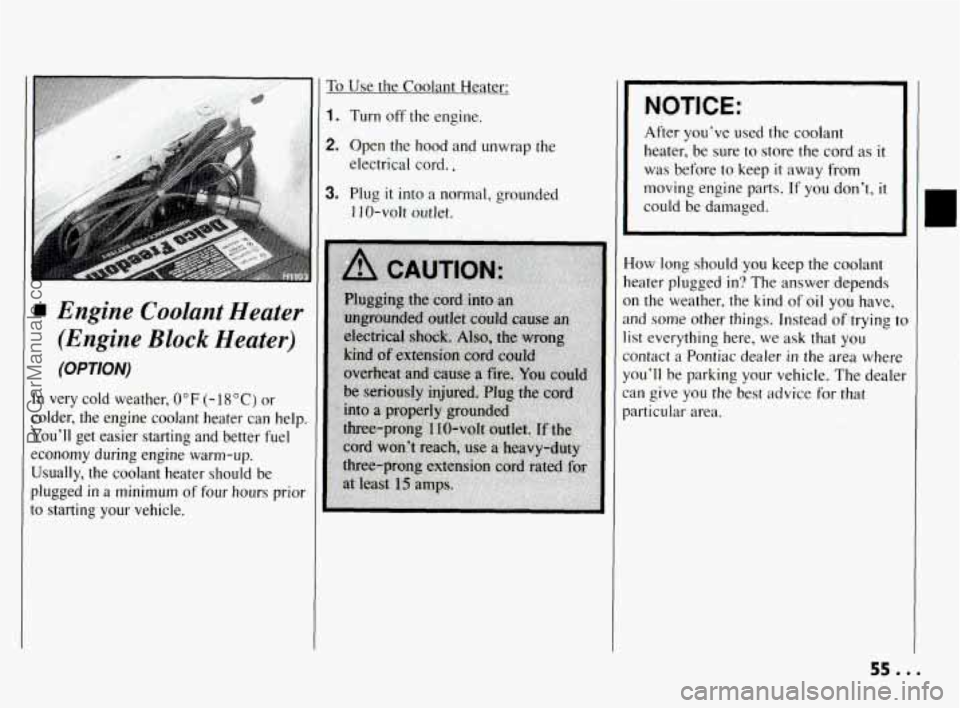
1 Engine Coolant Heater (Engine Block Heater)
(OPTION)
In very cold weather, 0" F (- 18 O C) or
colder, the engine coolant heater can help.
You'll get easier starting and better fuel
economy during engine warm-up.
Usually, the coolant heater should be
plugged
in a minimum of four hours prior
to starting your vehicle.
To Use the Coolant Heater:
1. Turn off the engine.
2. Open the hood and unwrap the
electrical cord.,
3. Plug it into a normal, grounded
110-volt outlet.
NOTICE:
After you've used the coolant
heater, be sure
to store the cord as it
was before to keep
it away from
moving engine parts. If
you don't, it
could be damaged.
How long should you keep the coolant
heater plugged in? The answer depends
on the weather, the kind of oil you have,
and
some other things. Instead of trying to
list everything here, we ask that you
contact a Pontiac dealer in the area where
you'll be parking your vehicle. The dealer
can give
you the best advice for that
particular area.
55.D.
ProCarManuals.com